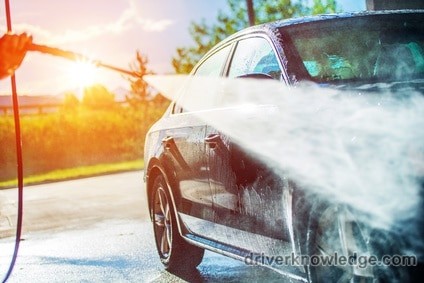Did you know that between the amount of water you use to soap up your sponges and the unrestricted flow of fresh water from your garden house, you can use up to between 80 and 140 gallons of water when you wash your car at home?
That water picks up a large amount of muck, dirt, and other nasty stuff that has been stuck to your car – oil, gasoline, tar, heavy metal particles, and particulate matter produced by exhaust fumes – and sends it from your driveway directly to nearby rivers or lakes. This water flows totally untreated as many storm drains do not go to a sewage treatment plant.
But you do not have to give up washing your car in the driveway and spend tons of money for a professional wash. There are eco-friendly ways to wash your car and ways to save water as well.
Do not wash on the pavement: Instead of washing your car on the pavement, do it on a flat, permeable surface like gravel, lawn, or dirt. Natural microbes in dirt, soil, and grass act as natural filters and break down some of the nasty compounds present in your wash water, preventing them from flowing into the nearest storm drain.
Do it yourself: If you are the type who enjoys the hands-on experience of washing and cleaning your car, go to a self-service car wash where they capture the run-off water and send it to a treatment plant. Many times, this is the most eco-friendly – and inexpensive – option, using only roughly 15 gallons of water. And you can use your own biodegradable dish soap.
A lot more water is used in those large commercial drive-through systems than in self-service places, between about 30 to 50 gallons, depending on the type. However, this is still a lot less than if you washed your car at home. Just remember to decline the wax job and special treatments and stick with a simple wash.
 Use waterless car wash products: While a long hose, oversized sponges, buckets, and soaked clothing are part and parcel of a traditional home car wash tradition, you do not really need any of these things to clean your vehicle and give it a green shine. There are many pre-made, eco-friendly waterless car wash products on the market that you can select. Or you can also use your homemade window cleaner and microfiber cleaning cloths or clean, soft, and absorbent rags.
Use waterless car wash products: While a long hose, oversized sponges, buckets, and soaked clothing are part and parcel of a traditional home car wash tradition, you do not really need any of these things to clean your vehicle and give it a green shine. There are many pre-made, eco-friendly waterless car wash products on the market that you can select. Or you can also use your homemade window cleaner and microfiber cleaning cloths or clean, soft, and absorbent rags.
If you are using a commercial product, make sure that you read the instructions carefully. If you are using a homemade cleaner, spray a small area with it, wipe the product as well as the dirt off with one cloth and use the second one to buff the area.
Wash with vinegar: Do you want to get rid of baked-on bugs from your car? Use a cleaner and allow it to sit for a few minutes before you wipe it off. They can also be loosened with a non-abrasive kitchen scrubby. Another great green way to clean away those nasty bugs it to use vinegar or denatured alcohol. Soak a cloth with either of them and soak and rub off any yucky bugs that have dried on your car. Rinse the area with water and rewax. If you leave the vinegar on, it can strip your car’s finish.
Score a squeegee: You can wash your windows inside and out, and work on the headlight and taillight glass and mirrors too. You can use a squeegee for this. Roll the windows down a little and clean the top edge first. Next, roll them up and clean the remaining part of the window. If fall is approaching, use an eco-friendly anti-fogging treatment to the parts that you have cleaned. There are quite a few good ones available on the market.
Use a natural deodorizer: The interior of your car needs cleaning too, so use a vacuum cleaner with a crevice tool to suck away debris under the seats and so on. Your upholstery probably needs freshening up too. You can sprinkle some baking soda onto the seats to absorb odor. Let it sit for 30 minutes to 2 hours before you vacuum it up. You will have a car that looks and smells fresh in no time.
Do some organic waxing: Forget about expensive car waxing products. You can make your own by mixing 2 parts olive oil and 1 part lemon juice in a small bowl. Take a soft cloth and dab a small amount and rub it over the dashboard and other surfaces made of vinyl or plastic. Remember not to apply it on the steering wheel, pedals, or other surfaces that should not be slippery. Take an old toothbrush and use it to apply the solution into cracks and remove dust and other particles that have been trapped inside. Next, buff with another dry, clean cloth – it will give the cleaned areas a soft shine and a fresh pleasant smell.
There are many ways to clean your car without harming the environment. With the help of these super-easy eco-friendly cleaning tips, you can have a clean car that shines and smells as good as when you take it to a professional.
